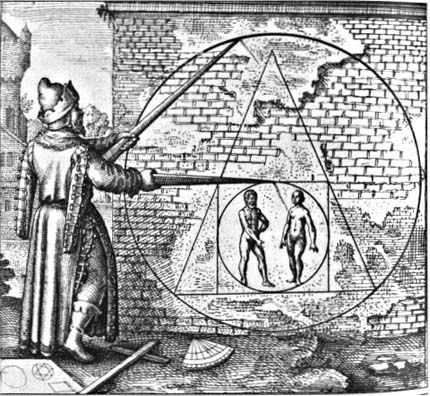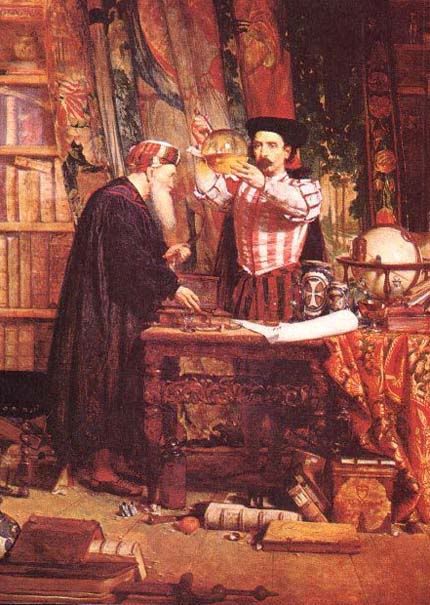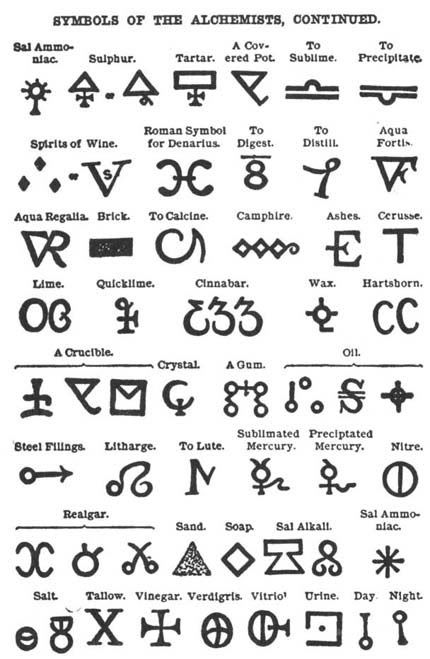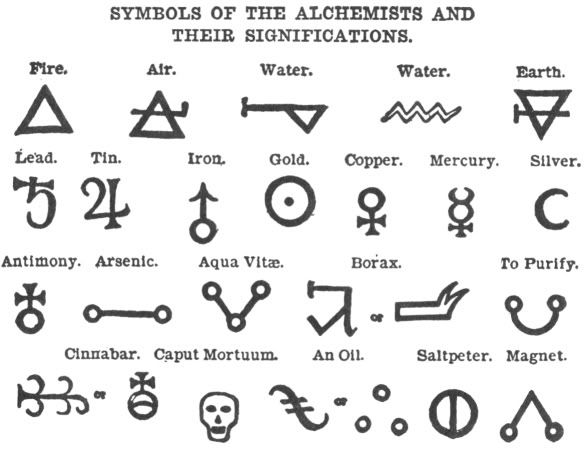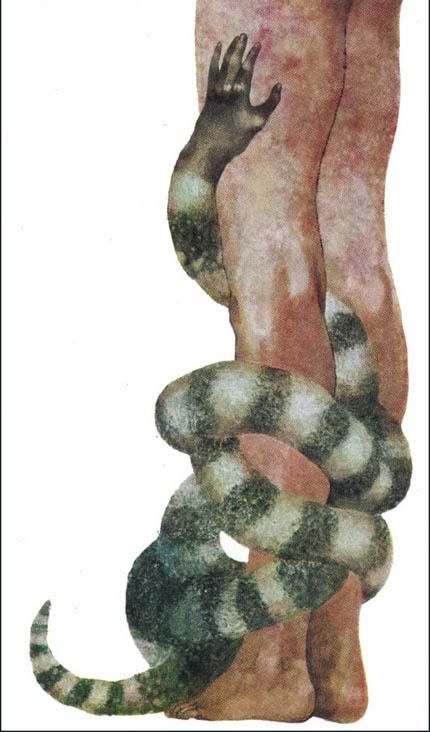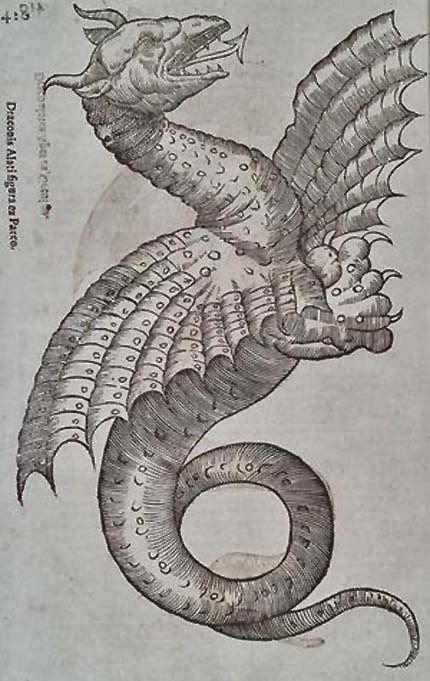 A while ago, I posted the D6 version of my Random Dragon Generator. This is the full-size version, along with an example dragon. As I said before, I make a distinction between, monsters, (species in the Gygaxian Naturalism tradition), and MONSTERS, (unnatural unique creatures which don't have to follow the rules of Nature). I employ both in my own Greyhawk, and my players can never be certain just what the hell they're up against in any given encounter. It adds spice to the game and checks the over confidence that leads to complacency and boredom.
A while ago, I posted the D6 version of my Random Dragon Generator. This is the full-size version, along with an example dragon. As I said before, I make a distinction between, monsters, (species in the Gygaxian Naturalism tradition), and MONSTERS, (unnatural unique creatures which don't have to follow the rules of Nature). I employ both in my own Greyhawk, and my players can never be certain just what the hell they're up against in any given encounter. It adds spice to the game and checks the over confidence that leads to complacency and boredom.Dragons especially seem to get over-defined in the game. Ancient and medieval dragons were extremely varied in form. Like elves and goblins and such in myth, they were rarely described in the same way consistently.
A randomly generated dragon will bring to your game some of that fear of the unknown which was the norm for people before the reign of technology.
The Random Unique Dragon Generator.
Intelligence.
roll 1d6
1. Animal
2. Low
3. Average *
4. Very
5. Highly
6. Genius
* If intelligence is greater than Average, there is a 20% chance of some form of madness. If so, roll on Mental Disorder Sub-table.
Alignment.
There is only a 20% chance the dragons alignment will be any form of Good. Roll 2d10 first, and then roll 1d8. Only if indicated by the percentile roll, can the dragon’s alignment be a Good one.
1. Lawful Good
2. Lawful Evil
3. Neutral Good
4. Neutral
5. Neutral Evil
6. Chaotic Good
7. Chaotic Evil
8. Alignment subject to change. Re-roll per encounter
Age.
roll 1d8
1. Very Young. 1 hit point per die.
2. Young. 2 hit points per die.
3. Sub-adult. 3 hit points per die.
4. Young adult. 4 hit points per die.
5. Adult. 5 hit points per die.
6. Old. 6 hit points per die.
7. Very old. 7 hit points per die.
8. Ancient. 8 hit points per die.
Size.
roll 1d6. The size list is very general, it is open to interpretation by the DM.
1. S (smaller than man-size, up to 140 lbs)
2. M (man-size, up to 300 lbs)
3. L (larger than man-size, up to 12 feet, 1000 lbs)
4. H (huge, up to 20 feet, 2000 lbs)
5. G (giant, up to 35 feet, 3500 lbs)
6. E (enormous, up to 55 feet, 5000 lbs)
Armor Class.
roll 1d8
1. Ac 8
2. Ac 6
3. Ac 4
4. Ac 2
5. Ac 0
6. Ac -1
7. Ac -2
8. Ac -3
Hit Dice.
roll 1d8
1. 4-6 hit dice
2. 5-7 hit dice
3. 6-8 hit dice
4. 7-9 hit dice
5. 8-10 hit dice
6. 9-12 hit dice
7. 10-13 hit dice
8. 11-14 hit dice
Move: On the ground/flying
roll 1d6
1. 6/18
2. 10/10
3. 12/24
4. 9/24
5. 9/30
6. 12/30
Number of attacks per round.
roll 1d6
1. 1 APR
2. 2 APR
3. 2 APR
4. 3 APR
5. 3 APR
6. 4 APR
Damage per attack.
roll 1d6 (Roll as many times as indicated by # of attacks per round)
1. 1-4
2. 1-6
3. 1-8
4. 1-10
5. 1-12
6. 2-12
Breath Weapon.
roll 1d8
1. No breath weapon
2. Fire. (as red dragon)
3. Cold. (as white dragon)
4. Acid. (as black dragon)
5. Poison Gas. (as green dragon)
6. Lightening. (as blue dragon)
7-8. Unique breath weapon. (roll on Unique Breath Weapon table)
Unique Breath Weapon.
Roll 1d10
1. Spittle ball causes random polymorph to those hit.
2. Laughing gas, save vs dragon breath or be rendered defenseless due to convulsions of laughter. (gas attack has same dimensions as green dragon toxic gas breath weapon)
3. Roar/cone of sound, does 1-8 points of damage per hit die, and causes permanent deafness to those failing save.
4. Dragon vomits forth a gusher of stinging insects. 1-4 points of damage per hit die, plus save vs poison or be immobilized with pain for a number of rounds equal to the dragons hit dice.
5. Breath becomes "Web" as per the spell.
6. A gust of "Sleep" fumes as per the spell.
7. A glob of protoplasm which transforms into a random monster under the dragon’s control.
8. Breath disintegrates metal. Only magic items may attempt to save.
9. Giant wad of phlegm which will glue victims to surfaces or to each other. The dragon will direct it at the highest concentration of foes. Alcohol will dissolve the phlegm in three rounds.
10. Hurricane force wind. Failure to save results in targets being dashed against closest obstruction. Calculate as falling damage.
Special Defenses. ( 2 in 6, or 35% chance of possessing.)
roll 1d10
1. Only hit by magic weapons.
2. Anti-magic field, 5' radius.
3. Chameleon, treat as elven cloak.
4. Constantly sheds caltrop-like scales. Unless characters have a dexterity greater than 14, they have a 20% chance per round of stepping on a shed scale and taking 2 points of damage when within twenty feet of the dragon.
5. Dragon is perpetually enveloped in fire. Coming within melee range causes 1-4 points of damage per round.
6. Miasmal fog surrounds the dragon. Anyone closing to melee range must save or contract random disease.
7. Dragon regenerates as does a troll.
8. Dragon is constantly coated in frost. Immune to cold-based attacks and anyone coming withing melee range must save or be frost-bitten for 1-4 points of damage a single time.
9. Dragon blinks as does a Blink Dog.
10. Dragon’s blood is poisonous. If wounded by an edged weapon, the attacker must save vs poison.
Special Attacks. ( 2 in 6, or 35% chance of possessing.)
roll 1d10
1. Dragon has claws of sharpness. On a natural twenty, the victim of the dragons claw attack will have a random limb severed.
2. Dragon Speech. Those hearing the dragon speak must save or be charmed and become the dragons staunch supporters.
3. Frog tongue. The dragon can attack as would a Cave Fisher.
4. Tail spines as a Manticore.
5. Gaze weapon causes diametric alignment shift. Treat as a Medusa’s gaze attack.
6. Dragon sprays caustic urine causing 2-12 points of damage and painful blistering.
7. A slap of the dragon’s tongue will cause madness. Target must save or be stricken with a random mental illness.
8. Dragon’s wings are edged with bony serrations. It may slash for 1-8 points of damage at targets twice as far away as normal melee range.
9. Dragon may speak a minor curse once per day. Example; "May you never wield a sword again!" The curse will hold until lifted by a cleric.
10. Dragon’s tail ends in a bone club. When stuck against the ground, or other hard surface, the bone club will shatter, hurling shrapnel in all directions. Those struck will take 1-6 points of damage. The club regrows within a day.
Special Abilities. ( 2 in 6, or 35% chance of possessing.)
roll 1d10
1. Dragon burrows as a Bullette
2. Dragon travels distances greater than 100 feet via natural Dimension Door.
3. Dragon possesses lernaean regeneration abilities. If it loses a head, or limb, it will regrow two to replace it within 1-4 rounds if the stump is not burned with fire.
4. The dragon may climb surfaces as would a giant gecko.
5. The dragon sprays a musk which will attract wandering monsters until removed by rubbing with pumpkin flesh. Every subsequent wandering monster check will result in an encounter.
6. The dragon is an oracle and may foretell events if persuaded.
7. As a displacer beast, the dragon always appears to be 3 feet from it’s actual position. This adds two points to it’s saving throws, and subtracts 2 points from opponents attack rolls.
8. The dragon has the ability to mimic the form of anyone it has recently observed. Treat as a doppleganger.
9. The dragon can see and strike ethereal and astral creatures, and those using magic to transport themselves to those planes.
10. Undead must obey the dragon. It cannot create, or summon them, but any encountered must heed it’s commands.
General Characteristics.
The dragon’s dominate features are generally:
roll 1d8
1. Mammalian. Bare flesh, or fur. The dragon exhibits qualities which are, cat-like, bearish, wolf-like, etc...
2. Reptilian. Scaled or pebbled hide. The dragon is serpent-like, crocodilian or dinosaurian.
3. Amphibian. Smooth and slimy skin. The dragon is salamander-like, or frogish.
4. Avian. Feathered and/or beaked and taloned. The dragon is somewhat bird-like.
5. Unnaturally monstrous. The dragon may not be native to this plane. It’s form may be difficult to discern, or may not be set. The dragon may be only partially material.
6. Construct. The dragon is a made thing. It may be like a flesh golum or built of unliving materials.
7. Humanoid dragon. The general form of the dragon’s body is similar to that of a man. Or, it may have human-like features, eyes, hands, a human like mouth, etc...
8. Amalgamation. Roll twice on this table and combine results to make a dragon which is truly bizarre.
General Form.
roll 1d20
1. Serpentine, no limbs.
2. Serpentine, winged
3. Serpentine, forelimbs only.
4. Serpentine, forelimbs and wings.
5. Serpentine, four legs only.
6. Serpentine, four legs and wings.
7. Serpentine, bipedal rear legs only.
8. Serpentine, bipedal rear legs and wings.
9. Serpentine, bipedal rear legs and fore arms.
10. Serpentine, bipedal rear legs, fore arms, and wings
11. Traditional heavy bodied dragon with four limbs and wings.
12. Bipedal, carnosaur-like.
13. Bipedal, carnosaur-like with wings.
14. Traditional heavy bodied dragon, four limbs only.
15. Multi-legged, six limbs or more.
16. Multi-legged, six limbs or more and winged
17. Multi-legged, one hundred limbs or more.
18. The dragon’s form changes after each encounter. Re-roll for beginning form.
19. The dragon lacks limbs. paws, claws, or hands attach directly to the body.
20. Head and body as one, no neck. Bipedal, long tail, no fore arms or wings.
Primary and Secondary colors.
Roll 1d8 twice for colors, Choose scheme or pattern as you like. (Spots, stripes, blotches, solids, etc...)
1. Black
2. White.
3. Red.
4. Green.
5. Blue.
6. Yellow.
7. Brown.
8. Grey.
% in lair.
roll 1d6.
1. 10%
2. 20%
3. 30%
4. 40%
5. 50%
6. 60%
Chance of Speaking/Magic-use/Sleeping
roll 1d6
1. 30%/10%/50%
2. 60%/30%/30%
3. 30%/30%/50%
4. 45%/40%/40%
5. 75%/40%/20%
6. 100%/100%/5%
Purpose or Obsession.
The thing which drives the dragons actions.
roll 1d12
1. Arcanovore. The dragon devours magic items, spell books, and spell casters.
2. The dragon lusts to accumulate treasure.
3. The dragon must eat sentient creatures.
4. The dragon loves music and collects musicians who must play for it’s enjoyment until they die.
5. Bibliophile. The dragon hoards knowledge. If it captures books which it cannot itself, read, it will search for persons who can be forced to read to it.
6. The dragon exists to foul pure wells and water sources.
7. The dragon collects maidens. It may or may not eat them.
8. The dragon destroys temples and priests regardless of alignment.
9. The dragon is obsessed with colorful fish.
10. The dragon always seeks to expand it’s personal desolation.
11. The dragon is zealously attempting to found it’s own religion, centered on the worship of itself.
12. Fighting is the dragon’s raison d’etre. It always seeks to match itself to the greatest possible foes.
Allies or Minions.
There is only a 25% chance the dragon will have either.
If so, roll 1d10
1. A second, lesser dragon of a standard type.
2. A second, lesser Randomly generated dragon.
3. A thrall monster. (roll on appropriate random wilderness encounter table.)
4. A non-dragon mate. The Random Unique Dragon is a Monster and capable of breeding with any other creature.
5. The dragon functions as the Local Lord. Roll for a group of fighters of the dominate area race.
6. The dragon is venerated by the locals. It will be defended by it’s Zealots who will sacrifice offenders to their "god".
7. The Local Lord placates the dragon by regular human sacrifices. He will prevent anyone upsetting the arrangement.
8. The dragons actions serve the purposes of a minor infernal power. There is a 20% chance that it may send demonic assistance if the dragon is hard pressed.
9. A famous dragon-slayer opposes any who would attempt to destroy the dragon before him.
10. The dragon is in-fact, an agent of, or controlled by, a neighboring power of the lands it is despoiling. Destroying it may upset plans the PCs know nothing about, and gain them the attention of powers of which they are unaware.
 The dragon generated by these lists may have apparent contradictions. The DM may re-roll attributes which cause conflicts, or he may come up with creative rationalizations which smooth out stat conflicts.
The dragon generated by these lists may have apparent contradictions. The DM may re-roll attributes which cause conflicts, or he may come up with creative rationalizations which smooth out stat conflicts.Many of the randomly generated statistics will require the DM to come up with plausible back-stories or justifications for exactly why the dragon is as it is, and why it does as it does. This, fleshing out of the dragon is nearly as much fun for the DM as it is when he gets to see the over confident PCs first encounter the Unique Dragon.
There is no promise that the randomly generated dragon will be a level-appropriate foe for the party. It could easily outmatch them, and it could just as easily be a push-over. The fun part is, they don't know which it is. The beast's size and appearance can be totally at odds with it's actual ability to deal out death.
An example dragon, Slurgorth, the Beast of the Black Vale. Rolled up with out any fudging of the dice, so help me Gary.
Intelligence: Highly intelligent. (I rolled a 5, and a 15% on the chance for mental problems, under the 20% required. Slurgorth has some form of insanity.)
Alignment: Subject to change, re-roll at each encounter. ( I rolled an 8 and re-rolled a 4, so, Slurgorth starts with a Neutral alignment.)
Age: Sub-adult, 3 hit points per die. ( rolled a 3, so Slurgorth is not as old and formidable as he might otherwise be.)
Size: L. ( I rolled a 3, so I’m going to make him maximum for the class, 12 feet long, and 1000 lbs.)
Armor class: -3. ( I rolled an 8, so Slurgorth is very difficult to hit and damage.)
Hit dice: 4-6. ( I rolled a 1, so Slurgorth dosen’t have as many hit dice as he might. I therefore go for the max allowed, 6 hit dice. This gives him 18 hit points at his age. Not a lot, but his high AC will compensate for this.)
Move: 6/18. ( I rolled a 1 again, Slurgorth moves slowly on the ground and flys heavily through the air.)
Attacks per round: 2 attacks per round. ( Rolled a 3, Slurgorth is slow enough that he doesn’t get two claws and a bite in the same round.)
Damage/attacks: 1-10/1-8. ( I rolled a 4, and a 3, Slurgorth’s clawed fore arms are more dangerous than his relatively weak bite.)
Breath weapon: ( I rolled an 8, indicating a unique breath weapon.)
Unique Breath Weapon: Slurgorth can expel a spittle ball which causes those struck to undergo a random polymorph. Roll on reincarnation tables to determine new form. Victim may save vs dragon breath to make the transformation temporary. As with standard breath weapons, this may be used three times per day.
Special defenses: nil. ( There is only a 35% chance of the dragon possessing special defenses, and I rolled above that, so nothing for Slurgorth.)
Special attacks: Slurgorth’s wings are edged with bony serrations. He may slash at targets twice normal melee range distant for 1-8 points of damage. This means he may attack first in the first round of melee regardless of initiative. ( I rolled a 10%, under the 35% required for Special attacks, and then an 8 for the wing serrations.)
Special abilities: nil. (I rolled above the 35% chance to possess special abilities.)
General characteristics. Amalgamation, Amphibian and Unnaturally Monstrous. ( I rolled an 8 and got amalgamation, and then a 3 and a 5. I decide that Slurgorth is a salamander-like thing from the outer dark, possibly brought here to this world accidentally. )
General Form: Serpentine and bipedal, with long taloned fore arms and wings. ( I rolled and got a 10. Slurgorth walks in a powerful, but shambling gait on it’s long hind legs. It’s terrible forearms hang nearly to the ground and it’s long flexible back allows it to quickly turn and attack in any direction. It’s mucous coated wings lie flat against it’s back when not in use. It’s pale and lamp-like eyes goggle about in search of victims.)
Colors: Slurgorth is a glistening black and mottled with a random pattern of brown speckling. ( I rolled a 1 for primary color, and a 7 for secondary.)
% in lair: 50% ( I rolled a 5, Slurgorth spends much time in it’s foul lair, contemplating it’s hopes for future malevolence. )
Chance of Speaking/Magic-use/Sleeping: 75% chance of speaking, 40% chance of magic-use, 20% chance of sleeping. (I rolled a 5. Slurgorth may or may not speak, quite possibly can use magic, and is rarely to be caught sleeping.)
Purpose or Obsessions: Arcanovore, Slurgorth compulsively devours anything with the scent of magic upon it, or them. It hopes that if it absorbs enough magical potential, it may be able to force a door to it’s place of origin. Perhaps to return home, or perhaps to bring others into this world. ( I rolled a 1.)
Allies or Minions: nil. ( I rolled above the 25% possibility that the dragon could have any allies.)





